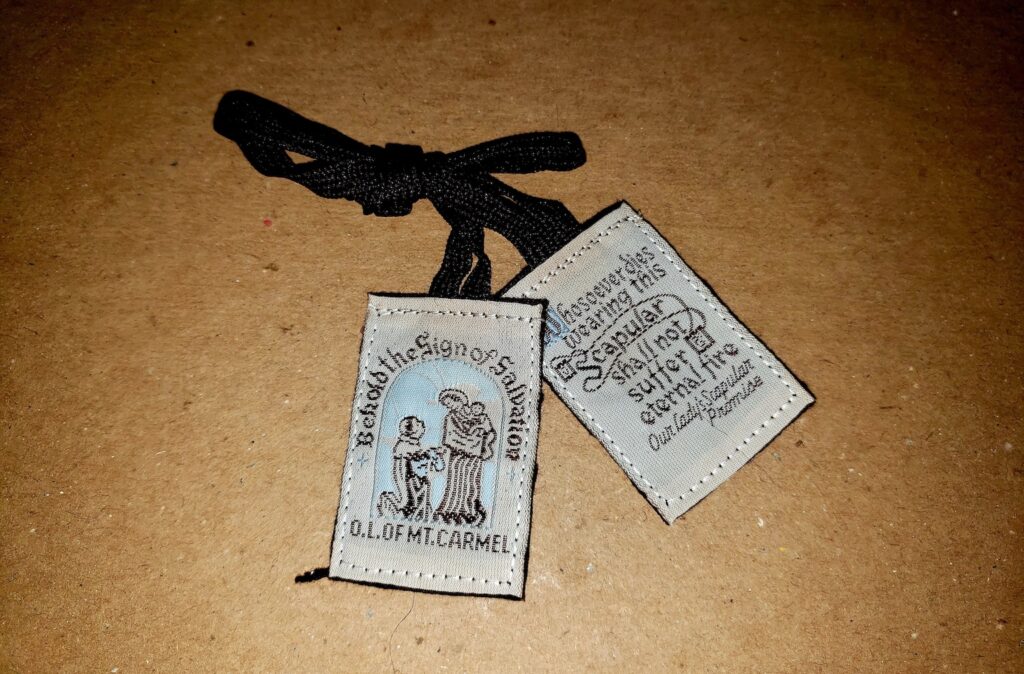July 13, 2020
The day after I made my first holy Communion, first communicants were all enrolled in the brown scapular. At the time I didn’t understand its significance.
What I remember most is that after the ceremony, a group picture was taken followed by the pastor’s declaration that there was no school for second-grade students that day. As you can imagine, the cheers that erupted overshadowed any catechesis we may have received, and so it’s no surprise that eventually, I stopped wearing it.
As often happens in the absence of proper understanding of a devotion or appreciation for sacramentals, they tend to fall by the wayside or, worse yet, are reduced to superstitious practice. However, since the Feast of Our Lady of Mount Carmel is this Thursday, July 16, and many Catholics, including myself, wear the brown scapular, a brief catechesis on the topic seems timely.
As a Secular Carmelite for almost 40 years, the brown scapular is more than an object of devotion for me. It’s a habit that defines my spirituality. The brown scapular, a powerful sign of Mary’s quiet unfailing love and presence as Mother and intercessor has been an essential part of the Carmelite habit since its inception.
The order was founded in the 13th century by a group of men who decided to live in community on Mount Carmel and were first known as the Brothers of the Blessed Virgin of Mount Carmel. Dedicating themselves to prayer and service, they vowed to live in allegiance to Jesus Christ in the spirit of Elijah under the patronage of Mary.
However, as the crusades intensified, the brothers fled to Europe where they became known as Carmelites. In 1247, they were recognized by Pope Innocent IV as a religious congregation with a deeply Marian character which eventually included nuns and lay members.
During the 14th century, a time of turbulence within the Carmelite community, the Blessed Mother appeared to a Carmelite priest, St. Simon Stock. Holding the Child Jesus, she handed the priest a miniature version of the Carmelite scapular with the promise that all who remain faithful to the Carmelite vocation until death will be granted the grace of final perseverance. Wishing to extend this privilege beyond the friars, nuns and secular members, Carmelites received the Church’s approval of its use as a sacramental for all Catholics.
However, the brown scapular is not a guarantee of heaven. It’s a sign of allegiance to Carmelite spirituality which includes frequent participation in Mass and reception of the Eucharist, regular meditation on the Scriptures, praying the rosary or at least part of the Liturgy of the Hours every day, and the practice of Christian virtues in imitation of Mary.
Unfortunately, over the years, well-meaning people have spread the devotion with extravagant claims that have no historical background and are difficult to reconcile with sound Christian doctrine.
The “Sabbatine” privilege that Mary will lead her devotees and wearers of the scapular from purgatory to heaven on the First Saturday of the month following their death is one such legend. In 1613, the Holy See pronounced the alleged appearance of Mary to Pope John XXII regarding the Sabbatine privilege unfounded and admonished the order for preaching the doctrine.
In recent times, Carmelite orders, both the Discalced (OCD) and the Ancient Observance (OCarm) have taken up the mandate to correct misconception by publishing the full catechesis regarding the brown scapular in the booklet, “The Scapular of Our Lady of Mount Carmel: Catechesis and Ritual.” The joint venture by five Carmelite provincials in the United States identifies principles concerning the Carmelite family, which include:
1. Members of public associations and confraternities of Our Lady of Mount Carmel, i.e., active communities of the Scapular Confraternity.
2. Those who have been invested in the scapular, practice the order’s spirituality, and have been granted some association with the order.
3. Those who wear the scapular out of devotion, practice the order’s spirituality, but have no formal association with the order.
4. Those who are committed to the Marian character of Carmelite spirituality but use outward forms other than the brown scapular to express this devotion.
A booklet on the full catechesis is available from ICS Publications www.icspublications.org.
However, whether Catholics are enrolled in the brown scapular or not, all do well to keep in mind the words of the Carmelite doctor of the Church, St. John of the Cross: “Strive to preserve your heart in peace; let no event of this world disturb it; reflect that all must come to an end.”
During these troubled times, his message is one we can all take to heart as we strive to follow Mary’s example and hold all we may not understand in our heart.

